A Review of Smart Photovoltaic Systems Which Are Using Remote-Control, AI, and Cybersecurity Approaches
Abstract
1. Introduction
- Analyzing different implementations of PV systems.
- Reviewing the literature on the remote control of PV systems.
- Reviewing the literature on AI techniques and methods applied in photovoltaics.
- Reviewing the literature on cybersecurity threats and vulnerabilities in smart PV systems and cyber-attacks on power systems.
- Discussing the architecture of PV systems and how they can be implemented easily, efficiently, and securely using remote-control, AI techniques, and cybersecurity methods.
2. Methodology
3. Modern Configuration of Photovoltaic Systems
- On-grid system—the main parts are the solar panels, inverter, meter, and consumers. Figure 4 presents a logical scheme of an on-grid system.
- Off-grid system—the system stores energy in batteries, and the main parts are the PV panels, charge controller, inverter, batteries, and consumers
- Hybrid system—stores the produced energy in batteries, and when the batteries are fully charged, the produced energy is then inserted into the grid. The main parts of the hybrid system are the solar panels, batteries, inverter, and consumers.
- the poor manufacturing of the batteries,
- the behavior of degraded batteries,
- the threshold of the charge controller to protect the battery against over-discharge.
4. PV Systems—Implementation and Remote-Control Methods
4.1. Use-Cases
4.2. Remote-Control Methods for PV Systems
- -
- Classical MPPT control techniques
- -
- Intelligent MPPT control techniques
- -
- Optimization techniques
- -
- Hybrid techniques
5. Artificial Intelligence
- Artificial Neural Network (ANN)
- Support vector-machine (SVM)/Support vector-regression (SVR)
- Generic Algorithm (GA)
- Bootstrap Aggregated Neural Networks (BANN)
- Back-propagation neural network (BPNN)
- Adaptive Neuro-Fuzzy Inference System (ANFIS)
- Naïve Bayes (NB)
- Historical Similar Mining (HISIMI)
- Transient System Simulation Tool (TRNSYS)
5.1. Artificial Intelligence Algorithms Integrated in PV Systems
5.2. Advantages and Disadvantages of AI for PV Systems
- data acquisition and auditing
- energy storage and grid integration issues
- performance and explain ability issues
- safety and protection against data breaches
- stability and generation in predictive modeling
- modeling of various faults simultaneously
6. Cybersecurity
6.1. Vulnerabilities and Threats for Photovoltaic Systems
- False data injection—once the intruders can change and manipulate the data collected from sensors, a cyber-attack named false data injection can be easily planned [79].
- Man-in-the-middle (MITM)—an intrusive party embeds itself within a conversation between two communication devices with the intention of eavesdropping on either one of the devices. This is achieved by making it appear to be a normal exchange of information [80].
- Denial of service (DoS)—the primary targets for this type of attack are the protocols, with the intention of overloading the communication channels [81].
- Replay—those engaged in malicious activities capture network traffic and act as the primary source by forwarding the traffic to the intended recipient. The attacker creates delays in data transfer or the data are resubmitted [82].
- Brute force attack—the objective of the attacker is to gain unauthorized access to the system by attempting to guess the usernames, passwords, or encryption keys on multiple occasions. In the event that malevolent actors have gained access to the system, they may remain undetected for an extended period, provided that they are able to masquerade as a legitimate user. Concurrently, they may establish clandestine access points, navigate the system undetected, comprehend its functionality and objectives, and procure confidential data. In addition, they are capable of configuring and executing malicious scripts [83].
- -
- the attackers and the vulnerabilities in the system
- -
- the produced impact
- -
- the repercussions of the attack
6.2. Cyber-Security Preventive and Detection Measurements for PV Systems
| References | Threats | Prevention/Detection Measures |
|---|---|---|
| [85] | False data injection attack | Neural network-based attack detection |
| Use of intrusion detection system | ||
| Add intrusion signatures | ||
| Add proxy and firewall rules | ||
| Access parameter sanitization | ||
| [88] | Encryption mechanism: Transport Layer Security (TLS) protocol | |
| [89] | Denial of service attack | Firewall rules |
| Antivirus solution installed | ||
| [90] | Encryption implementation | |
| [91] | Prediction framework: cellular computational network (CCN) | |
| [92] | IDS | |
| [80] | Man-in-the-middle attack | Communication protocol encryption |
| Network security (microsegmentation, firewall, proxy, load balancer rules) | ||
| [93] | Data encryption | |
| [94] | Encryption and checksum implementation | |
| [95] | Transport Layer Security (TLS) protocol | |
| [92] | SSH public key authentication | |
| [93] | Relay attack | Use of secured protocol (sTELNET instead of TELNET protocol, or FTP-SSL for file transfer instead of DTP) |
| [93] | Password attack | Implementation of least privilege principle |
| Implementation of MFA (Multi-factor authentication) | ||
| [96] | Strong password | |
| Role-based access |
6.3. Cyber-Attacks on Power Energy
7. Discussion
- The system implementation as in Case 1.
- A monitoring solution for detecting faults and anomalies of PV system, as in Case 2, and notifying the user when an unplanned event occurs.
- A simple remote-monitoring solution which collects data in real-time (Case 9), and the user can easily access the collected data from PV system, as in Case 5. In addition, the supervision application should have functionalities to predict energy consumption, as in Case 6.
- A good control system for energy storage (Case 8) and consumption (Case 7) which could take predefined actions in specific situations, especially in risky cases which potential damages.
- Physical (Case 1) and digital security: similar to Case 9, which should be made better by using the HTTPS protocol, but also Case 10 proposed data transfer with the minimal security offered by Internet protocols.
8. Conclusions
Author Contributions
Funding
Institutional Review Board Statement
Data Availability Statement
Conflicts of Interest
References
- Chen, C.J. Physics of Solar Energy and Energy Storage, 2nd ed.; John Wiley & Sons: Hoboken, NJ, USA, 2023. [Google Scholar]
- Abdulla, H.; Sleptchenko, A.; Nayfeh, A. Photovoltaic systems operation and maintenance: A review and future directions. Renew. Sustain. Energy Rev. 2024, 195, 114342. [Google Scholar] [CrossRef]
- Pourasl, H.H.; Barenji, R.V.; Khojastehnezhad, V.M. Solar energy status in the world: A comprehensive review. Energy Rep. 2023, 10, 3474–3493. [Google Scholar] [CrossRef]
- Urbanus, M.; Fandi, G.; Mgaya, E.; Muller, Z.; Tlusty, J. Stand-alone Solar Photo-voltaic Systems for Off-grid Electrification. Renew. Energy Res. Appl. 2024, 5, 1–9. [Google Scholar]
- Paiano, A.; Lagioia, G.; Ingrao, C. A combined assessment of the energy, economic and environmental performance of a photovoltaic system in the Italian context. Sci. Total Environ. 2023, 866, 161329. [Google Scholar] [CrossRef] [PubMed]
- Mishra, D.; Tummala, R.; Brigmon, T.; Jain, A. Simulations-based investigation of the effectiveness of fire suppression techniques for safe, large-scale storage of Li-ion batteries. J. Energy Storage 2024, 84, 110870. [Google Scholar] [CrossRef]
- Wang, Z.; Luther, M.; Horan, P.; Matthews, J.; Liu, C. Technical and economic analyses of PV battery systems considering two different tariff policies. Sol. Energy 2024, 267, 112189. [Google Scholar] [CrossRef]
- Wenham, S.R.; Green, M.A.; Watt, M.E.; Corkish, R. Applied Photovoltaics, 2nd ed.; Routledge: London, UK, 2017; ISBN 1-84407-401-3. [Google Scholar]
- Ansari, S.; Ayob, A.; Lipu, M.S.H.; Saad, M.H.M.; Hussain, A. A Review of Monitoring Technologies for Solar PV Systems Using Data Processing Modules and Transmission Protocols: Progress, Challenges and Prospects. Sustainability 2021, 13, 8120. [Google Scholar] [CrossRef]
- Louzazni, M.; Mosalam, H.; Cotfas, D.T. Forecasting of photovoltaic power by means of non-linear auto-regressive exogenous artificial neural network and time series analysis. Electronics 2021, 10, 1953. [Google Scholar] [CrossRef]
- Zahran, M.; Atia, Y.; Alhosseen, A.; El-Sayed, I. Wired and wireless remote control of PV system. WSEAS Trans. Syst. Control 2010, 5, 656–666. [Google Scholar]
- Shariff, F.; Rahim, N.A.; Hew, W.P. Grid-connected photovoltaic system: Monitoring insights. In Proceedings of the 3rd IET International Conference on Clean Energy and Technology (CEAT), Kuching, Malaysia, 24–26 November 2014; IET: Stevenage, UK, 2014; pp. 1–5. [Google Scholar]
- Samara, S.; Natsheh, E. Intelligent real-time photovoltaic panel monitoring system using artificial neural networks. IEEE Access 2019, 7, 50287–50299. [Google Scholar] [CrossRef]
- Chang, C.C.W.; Ding, T.J.; Tak, Y.C.; Paw, J.K.S.; Phing, C.C. Embedded Control and Remote Monitoring for Photovoltaic Solar Energy Harvesting Systems: A Review. J. Phys. Conf. Ser. 2022, 2319, 012002. [Google Scholar] [CrossRef]
- Harrou, F.; Taghezouit, B.; Bouyeddou, B.; Sun, Y. Cybersecurity of photovoltaic systems: Challenges, threats, and mitigation strategies: A short survey. Front. Energy Res. 2023, 11, 1274451. [Google Scholar] [CrossRef]
- Ali Khan, M.Y.; Liu, H.; Yang, Z.; Yuan, X. A comprehensive review on grid connected photovoltaic inverters, their modulation techniques, and control strategies. Energies 2020, 13, 4185. [Google Scholar] [CrossRef]
- Ferrier, E. LibGuides: Guide to Searching: Citation Searching. Available online: https://libguides.brown.edu/searching/citation (accessed on 13 June 2024).
- Moher, D.; Shamseer, L.; Clarke, M.; Ghersi, D.; Liberati, A.; Petticrew, M.; Shekelle, P.; Stewart, L.A.; Prisma-P Group. Preferred reporting items for systematic review and meta-analysis protocols (PRISMA-P) 2015 statement. Syst. Rev. 2015, 4, 1. [Google Scholar] [CrossRef] [PubMed]
- Triki-Lahiani, A.; Abdelghani, A.B.B.; Slama-Belkhodja, I. Fault detection and monitoring systems for photovoltaic installations: A review. Renew. Sustain. Energy Rev. 2018, 82, 2680–2692. [Google Scholar] [CrossRef]
- Mohammadi, F.; Sanjari, M.; Saif, M. A real-time blockchain-based state estimation system for battery energy storage systems. In Proceedings of the 2022 IEEE Kansas power and energy conference (KPEC), Manhattan, KS, USA, 25–26 April 2022; pp. 1–4. [Google Scholar]
- Deshmukh, M.K.; Singh, A.B. Online monitoring of roof-mounted stand-alone solar photovoltaic system on residential building. Mater. Today Proc. 2020, 23, 56–61. [Google Scholar] [CrossRef]
- Taghezouit, B.; Harrou, F.; Sun, Y.; Arab, A.H.; Larbes, C. A simple and effective detection strategy using double exponential scheme for photovoltaic systems monitoring. Sol. Energy 2021, 214, 337–354. [Google Scholar] [CrossRef]
- Harrou, F.; Dairi, A.; Taghezouit, B.; Sun, Y. An unsupervised monitoring procedure for detecting anomalies in photovoltaic systems using a one-class support vector machine. Sol. Energy 2019, 179, 48–58. [Google Scholar] [CrossRef]
- Emamian, M.; Eskandari, A.; Aghaei, M.; Nedaei, A.; Sizkouhi, A.M.; Milimonfared, J. Cloud computing and IoT based intelligent monitoring system for photovoltaic plants using machine learning techniques. Energies 2022, 15, 3014. [Google Scholar] [CrossRef]
- Okeke, R.O.; Orimadike, S.O. Enhanced Cloud Computing Security Using Application-Based Multi-Factor Authentication (MFA) for Communication Systems. Eur. J. Electr. Eng. Comput. Sci. 2024, 8, 1–8. [Google Scholar] [CrossRef]
- Zhao, H.; Che, Y.; Wen, G.; Chen, Y. Fault Monitoring Strategy for PV System Based on IV Feature Library. Energy Eng. 2024, 121, 643–660. [Google Scholar] [CrossRef]
- Iksan, N.; Sutanto, H. Smart Micro Grid Architecture for Realtime Monitoring of Solar Photovoltaic Based on Internet of Things. In IOP Conference Series: Earth and Environmental Science; IOP Publishing: Bristol, UK, 2023; Volume 1203, p. 012042. [Google Scholar]
- Ko, W.H.; Ramos-Ruiz, J.A.; Huang, T.; Kim, J.; Ibrahim, H.; Enjeti, P.N.; Kumar, P.R.; Xie, L. Robust dynamic watermarking for cyber-physical security of inverter-based resources in power distribution systems. IEEE Trans. Ind. Electron. 2023, 71, 7106–7116. [Google Scholar] [CrossRef]
- Khafaga, D.S.; El-kenawy, E.S.M.; Alhussan, A.A.; Eid, M.M. Forecasting Energy Consumption Using a Novel Hybrid Dipper Throated Optimization and Stochastic Fractal Search Algorithm. Intell. Autom. Soft Comput. 2023, 37, 2117–2132. [Google Scholar] [CrossRef]
- Arévalo, P.; Benavides, D.; Tostado-Véliz, M.; Aguado, J.A.; Jurado, F. Smart monitoring method for photovoltaic systems and failure control based on power smoothing techniques. Renew. Energy 2023, 205, 366–383. [Google Scholar] [CrossRef]
- Amorim, W.C.S.; Cupertino, A.F.; Pereira, H.A.; Mendes, V.F. On sizing of battery energy storage systems for PV plants power smoothing. Electr. Power Syst. Res. 2024, 229, 110114. [Google Scholar] [CrossRef]
- Kumar, M. Control techniques for operation of roof-top solar photovoltaics based microgrid in islanded mode. Int. J. Electr. Power Energy Syst. 2024, 155, 109511. [Google Scholar] [CrossRef]
- Krishna Rao, C.; Sahoo, S.K.; Yanine, F.F. An IoT-based intelligent smart energy monitoring system for solar PV power generation. Energy Harvest. Syst. 2024, 11, 20230015. [Google Scholar] [CrossRef]
- Kunduru, A.R. Security concerns and solutions for enterprise cloud computing applications. Asian J. Res. Comput. Sci. 2023, 15, 24–33. [Google Scholar] [CrossRef]
- Cano, J.M.; Herrera, R.S.; Martin, A.D.; Vazquez, J.R. Complete and versatile remote controller for PV systems. Int. J. Electr. Power Energy Syst. 2022, 142, 108324. [Google Scholar] [CrossRef]
- Arulkumar, K.; Palanisamy, K.; Vijayakumar, D. Recent advances and control techniques in grid connected PV system–A review. Int. J. Renew. Energy Res. 2016, 6, 1037–1049. [Google Scholar]
- Okhorzina, A.; Bikbulatov, A.; Yurchenko, A.V.; Bernhard, N.; Aldoshina, O. The development of monitoring and control system of the low PV/T solar system. MATEC Web of Conferences. In Proceedings of the VII Scientific Conference with International Participation “Information-Measuring Equipment and Technologies” (IME&T 2016), Tomsk, Russia, 25–28 May 2016; EDP Sciences: Les Ulis, France, 2016; Volume 79, p. 1010. [Google Scholar]
- Gupta, V.; Sharma, M.; Pachauri, R.K.; Babu, K.D. A low-cost real-time IOT enabled data acquisition system for monitoring of PV system. Energy Sources Part A Recovery Util. Environ. Eff. 2021, 43, 2529–2543. [Google Scholar] [CrossRef]
- Drews, A.; De Keizer, A.C.; Beyer, H.G.; Lorenz, E.; Betcke, J.; Van Sark, W.G.J.H.M.; Heydenreich, W.; Wiemken, E.; Stettler, S.; Toggweiler, P.; et al. Monitoring and remote failure detection of grid-connected PV systems based on satellite observations. Sol. Energy 2007, 81, 548–564. [Google Scholar] [CrossRef]
- Cano, J.M.; Martin, A.D.; Herrera, R.S.; Vazquez, J.R.; Ruiz-Rodriguez, F.J. Grid-connected PV systems controlled by sliding via wireless communication. Energies 2021, 14, 1931. [Google Scholar] [CrossRef]
- Kandemir, E.; Cetin, N.S.; Borekci, S. A comprehensive overview of maximum power extraction methods for PV systems. Renew. Sustain. Energy Rev. 2017, 78, 93–112. [Google Scholar] [CrossRef]
- Ko, J.S.; Huh, J.H.; Kim, J.C. Overview of maximum power point tracking methods for PV system in micro grid. Electronics 2020, 9, 816. [Google Scholar] [CrossRef]
- Katche, M.L.; Makokha, A.B.; Zachary, S.O.; Adaramola, M.S. A comprehensive review of maximum power point tracking (mppt) techniques used in solar pv systems. Energies 2023, 16, 2206. [Google Scholar] [CrossRef]
- Mahdi, A.S.; Mahamad, A.K.; Saon, S.; Tuwoso, T.; Elmunsyah, H.; Mudjanarko, S.W. Maximum power point tracking using perturb and observe, fuzzy logic and ANFIS. SN Appl. Sci. 2020, 2, 89. [Google Scholar] [CrossRef]
- Yaichi, M.; Fellah, M.K.; Mammeri, A. A neural network based MPPT technique controller for photovoltaic pumping system. Int. J. Power Electron. Drive Syst. 2014, 4, 241. [Google Scholar] [CrossRef]
- Lasheen, M.; Abdel-Salam, M. Maximum power point tracking using Hill Climbing and ANFIS techniques for PV applications: A review and a novel hybrid approach. Energy Convers. Manag. 2018, 171, 1002–1019. [Google Scholar] [CrossRef]
- Killi, M.; Samanta, S. Voltage-sensor-based MPPT for stand-alone PV systems through voltage reference control. IEEE J. Emerg. Sel. Top. Power Electron. 2018, 7, 1399–1407. [Google Scholar] [CrossRef]
- Sa-ngawong, N.; Ngamroo, I. Intelligent photovoltaic farms for robust frequency stabilization in multi-area interconnected power system based on PSO-based optimal Sugeno fuzzy logic control. Renew. Energy 2015, 74, 555–567. [Google Scholar] [CrossRef]
- Ali AI, M.; Mohamed, H.R.A. Improved P&O MPPT algorithm with efficient open-circuit voltage estimation for two-stage grid-integrated PV system under realistic solar radiation. Int. J. Electr. Power Energy Syst. 2022, 137, 107805. [Google Scholar]
- Rezk, H.; Fathy, A.; Abdelaziz, A.Y. A comparison of different global MPPT techniques based on meta-heuristic algorithms for photovoltaic system subjected to partial shading conditions. Renew. Sustain. Energy Rev. 2017, 74, 377–386. [Google Scholar] [CrossRef]
- Leedy, A.W.; Guo, L.; Aganah, K.A. A constant voltage MPPT method for a solar powered boost converter with DC motor load. In Proceedings of the 2012 Proceedings of IEEE Southeastcon, Orlando, FL, USA, 15–18 March 2012; pp. 1–6. [Google Scholar]
- Mellit, A.; Kalogirou, S.A.; Hontoria, L.; Shaari, S. Artificial intelligence techniques for sizing photovoltaic systems: A review. Renew. Sustain. Energy Rev. 2009, 13, 406–419. [Google Scholar] [CrossRef]
- Goel, A.; Goel, A.K.; Kumar, A. The role of artificial neural network and machine learning in utilizing spatial information. Spat. Inf. Res. 2023, 31, 275–285. [Google Scholar] [CrossRef]
- Shrestha, A.; Mahmood, A. Review of deep learning algorithms and architectures. IEEE Access 2019, 7, 53040–53065. [Google Scholar] [CrossRef]
- Calin, A.M.; Alexandru, M.; Nicula, D. Experiment-Supported Mobile Application for Monitoring Human Activities Using Neural Networks. In Interactive Mobile Communication, Technologies and Learning; Springer International Publishing: Cham, Switzerland, 2021; pp. 778–787. [Google Scholar]
- Zor, K.; Timur, O.; Teke, A. A state-of-the-art review of artificial intelligence techniques for short-term electric load forecasting. In Proceedings of the 2017 6th International Youth Conference on Energy (IYCE), Budapest, Hungary, 21–24 June 2017; pp. 1–7. [Google Scholar]
- Zhao, H.X.; Magoulès, F. A review on the prediction of building energy consumption. Renew. Sustain. Energy Rev. 2012, 16, 3586–3592. [Google Scholar] [CrossRef]
- Yorukoglu, M.; Celik, A.N. A critical review on the estimation of daily global solar radiation from sunshine duration. Energy Convers. Manag. 2006, 47, 2441–2450. [Google Scholar] [CrossRef]
- Mellit, A. Artificial intelligence based-modeling for sizing of a stand-alone photovoltaic power system: Proposition for a new model using neuro-fuzzy system (ANFIS). In Proceedings of the 2006 3rd International IEEE Conference Intelligent Systems, London, UK, 4–6 September 2006; pp. 606–611. [Google Scholar]
- Shaban, W.M. Detection and classification of photovoltaic module defects based on artificial intelligence. Neural Comput. Appl. 2024, 36, 1–28. [Google Scholar] [CrossRef]
- Vodapally, S.N.; Ali, M.H. Overview of Intelligent Inverters and Associated Cybersecurity Issues for a Grid-Connected Solar Photovoltaic System. Energies 2023, 16, 5904. [Google Scholar] [CrossRef]
- Mohammad, A.; Mahjabeen, F. Revolutionizing solar energy: The impact of artificial intelligence on photovoltaic systems. Int. J. Multidiscip. Sci. Arts 2023, 2, 1174–1187. [Google Scholar] [CrossRef]
- Tawalbeh, M.; Al-Othman, A.; Kafiah, F.; Abdelsalam, E.; Almomani, F.; Alkasrawi, M. Environmental impacts of solar photovoltaic systems: A critical review of recent progress and future outlook. Sci. Total Environ. 2021, 759, 143528. [Google Scholar] [CrossRef]
- Belabbes, F.; Cotfas, D.T.; Cotfas, P.A.; Medles, M. Using the snake optimization metaheuristic algorithms to extract the photovoltaic cells parameters. Energy Convers. Manag. 2023, 292, 117373. [Google Scholar] [CrossRef]
- Gao, X.; Cui, Y.; Hu, J.; Xu, G.; Wang, Z.; Qu, J.; Wang, H. Parameter extraction of solar cell models using improved shuffled complex evolution algorithm. Energy Convers. Manag. 2018, 157, 460–479. [Google Scholar] [CrossRef]
- Lo Brano, V.; Ciulla, G.; Di Falco, M. Artificial neural networks to predict the power output of a PV panel. Int. J. Photoenergy 2014, 2014, 193083. [Google Scholar] [CrossRef]
- Mallesham, G.; Mishra, S.; Jha, A.N. Automatic generation control of microgrid using artificial intelligence techniques. In Proceedings of the 2012 IEEE Power and Energy Society General Meeting, San Diego, CA, USA, 22–26 July 2012; pp. 1–8. [Google Scholar]
- Ghimire, S.; Nguyen-Huy, T.; Prasad, R.; Deo, R.C.; Casillas-Pérez, D.; Salcedo-Sanz, S.; Bhandari, B. Hybrid convolutional neural network-multilayer perceptron model for solar radiation prediction. Cogn. Comput. 2023, 15, 645–671. [Google Scholar] [CrossRef]
- Mohamed, Z.E.; Saleh, H.H. Potential of machine learning based support vector regression for solar radiation prediction. Comput. J. 2023, 66, 399–415. [Google Scholar] [CrossRef]
- Shaiek, Y.; Smida, M.B.; Sakly, A.; Mimouni, M.F. Comparison between conventional methods and GA approach for maximum power point tracking of shaded solar PV generators. Sol. Energy 2013, 90, 107–122. [Google Scholar] [CrossRef]
- Xue, X. Prediction of daily diffuse solar radiation using artificial neural networks. Int. J. Hydrogen Energy 2017, 42, 28214–28221. [Google Scholar] [CrossRef]
- Dahmani, A.; Ammi, Y.; Hanini, S.; Redha Yaiche, M.; Zentou, H. Prediction of hourly global solar radiation: Comparison of neural networks/bootstrap aggregating. Kem. U Ind. Časopis Kemičara I Kem. Inženjera Hrvat. 2023, 72, 201–213. [Google Scholar] [CrossRef]
- Fouilloy, A.; Voyant, C.; Notton, G.; Motte, F.; Paoli, C.; Nivet, M.L.; Guillot, E.; Duchaud, J.L. Solar irradiation prediction with machine learning: Forecasting models selection method depending on weather variability. Energy 2018, 165, 620–629. [Google Scholar] [CrossRef]
- Borni, A.; Abdelkrim, T.; Bouarroudj, N.; Bouchakour, A.; Zaghba, L.; Lakhdari, A.; Zarour, L. Optimized MPPT controllers using GA for grid connected photovoltaic systems, comparative study. Energy Procedia 2017, 119, 278–296. [Google Scholar] [CrossRef]
- Mishra, N.; Jhan, A.; Singh, A.; Mishra, S. An Upgrade to Power Output of Solar Panel utilizing MPPT with Artificial Intelligence. In Proceedings of the 2022 International Conference on Data Science, Agents & Artificial Intelligence (ICDSAAI), Chennai, India, 8–10 December 2022; Volume 1, pp. 1–5. [Google Scholar]
- Al Smadi, T.; Handam, A.; Gaeid, K.S.; Al-Smadi, A.; Al-Husban, Y. Artificial intelligent control of energy management PV system. Results Control Optim. 2024, 14, 100343. [Google Scholar] [CrossRef]
- Su, S.; Yan, X.; Agbossou, K.; Chahine, R.; Zong, Y. Artificial intelligence for hydrogen-based hybrid renewable energy systems: A review with case study. J. Phys. Conf. Ser. 2022, 2208, 012013. [Google Scholar] [CrossRef]
- Rekeraho, A.; Cotfas, D.T.; Cotfas, P.A.; Bălan, T.C.; Tuyishime, E.; Acheampong, R. Cybersecurity challenges in IoT-based smart renewable energy. Int. J. Inf. Secur. 2024, 23, 101–117. [Google Scholar] [CrossRef]
- Ameli, A.; Hooshyar, A.; Yazdavar, A.H.; El-Saadany, E.F.; Youssef, A. Attack detection for load frequency control systems using stochastic unknown input estimators. IEEE Trans. Inf. Forensics Secur. 2018, 13, 2575–2590. [Google Scholar] [CrossRef]
- Wlazlo, P.; Sahu, A.; Mao, Z.; Huang, H.; Goulart, A.; Davis, K.; Zonouz, S. Man-in-the-middle attacks and defence in a power system cyber-physical testbed. IET Cyber-Phys. Syst. Theory Appl. 2021, 6, 164–177. [Google Scholar] [CrossRef]
- Zhang, X.M.; Han, Q.L.; Ge, X.; Ding, L. Resilient control design based on a sampled-data model for a class of networked control systems under denial-of-service attacks. IEEE Trans. Cybern. 2019, 50, 3616–3626. [Google Scholar] [CrossRef]
- Gunduz, M.Z.; Das, R. Cyber-security on smart grid: Threats and potential solutions. Comput. Netw. 2020, 169, 107094. [Google Scholar] [CrossRef]
- Islam, S.N.; Baig, Z.; Zeadally, S. Physical layer security for the smart grid: Vulnerabilities, threats, and countermeasures. IEEE Trans. Ind. Inform. 2019, 15, 6522–6530. [Google Scholar] [CrossRef]
- Ahsan, M.; Nygard, K.E.; Gomes, R.; Chowdhury, M.M.; Rifat, N.; Connolly, J.F. Cybersecurity threats and their mitigation approaches using Machine Learning—A Review. J. Cybersecur. Priv. 2022, 2, 527–555. [Google Scholar] [CrossRef]
- Dubasi, Y.; Khan, A.; Li, Q.; Mantooth, A. Security vulnerability and mitigation in photovoltaic systems. In Proceedings of the 2021 IEEE 12th International Symposium on Power Electronics for Distributed Generation Systems (PEDG), Chicago, IL, USA, 28 June–1 July 2021; pp. 1–7. [Google Scholar]
- National Vulnerability Database. Available online: https://nvd.nist.gov/ (accessed on 11 June 2024).
- Shaukat, K.; Luo, S.; Chen, S.; Liu, D. Cyber threat detection using machine learning techniques: A performance evaluation perspective. In Proceedings of the 2020 international conference on cyber warfare and security (ICCWS), Norfolk, VA, USA, 12–13 March 2020; pp. 1–6. [Google Scholar]
- Dong, Z.Y.J.; Liang, G.; Luo, F.; Weller, S.; Zhao, J.H. A Review of False Data Injection Attacks Against Modern Power Systems. 2017. IEEE Trans. Smart Grid 2016, 8, 1630–1638. [Google Scholar]
- Li, Z.; Shahidehpour, M.; Aminifar, F. Cybersecurity in distributed power systems. Proc. IEEE 2017, 105, 1367–1388. [Google Scholar] [CrossRef]
- Liang, L.; Zheng, K.; Sheng, Q.; Wang, W.; Fu, R.; Huang, X. A denial of service attack method for IoT system in photovoltaic energy system. In Proceedings of the Network and System Security: 11th International Conference, NSS 2017, Helsinki, Finland, 21–23 August 2017; Proceedings 11. Springer International Publishing: Berlin/Heidelberg, Germany, 2017; pp. 613–622. [Google Scholar]
- Zhong, X.; Jayawardene, I.; Venayagamoorthy, G.K.; Brooks, R. Denial of service attack on tie-line bias control in a power system with PV plant. IEEE Trans. Emerg. Top. Comput. Intell. 2017, 1, 375–390. [Google Scholar] [CrossRef]
- Dafalla, Y.; Liu, B.; Hahn, D.A.; Wu, H.; Ahmadi, R.; Bardas, A.G. Prosumer nanogrids: A cybersecurity assessment. IEEE Access 2020, 8, 131150–131164. [Google Scholar] [CrossRef]
- Carter, C.; Onunkwo, I.; Cordeiro, P.; Johnson, J. Cyber security assessment of distributed energy resources. In Proceedings of the 2017 IEEE 44th Photovoltaic Specialist Conference (PVSC), Washington, DC, USA, 25–30 June 2017; pp. 2135–2140. [Google Scholar]
- Tertytchny, G.; Karbouj, H.; Hadjidemetriou, L.; Charalambous, C.; Michael, M.K.; Sazos, M.; Maniatakos, M. Demonstration of man in the middle attack on a commercial photovoltaic inverter providing ancillary services. In Proceedings of the 2020 IEEE CyberPELS (CyberPELS), Miami, FL, USA, 13–13 October 2020; pp. 1–7. [Google Scholar]
- Kang, B.; Maynard, P.; McLaughlin, K.; Sezer, S.; Andrén, F.; Seitl, C.; Kupzog, F.; Strasser, T. Investigating cyber-physical attacks against IEC 61850 photovoltaic inverter installations. In Proceedings of the 2015 IEEE 20th Conference on Emerging Technologies & Factory Automation (ETFA), Luxembourg, 8–11 September 2015; pp. 1–8. [Google Scholar]
- Sundararajan, A.; Chavan, A.; Saleem, D.; Sarwat, A.I. A survey of protocol-level challenges and solutions for distributed energy resource cyber-physical security. Energies 2018, 11, 2360. [Google Scholar] [CrossRef]
- Sullivan, J.E.; Kamensky, D. How cyber-attacks in Ukraine show the vulnerability of the US power grid. Electr. J. 2017, 30, 30–35. [Google Scholar] [CrossRef]
- Alert, I.-C. Cyber-attack against ukrainian critical infrastructure. In Cybersecurity Infrastruct; Tech. Rep. ICS Alert (IR-ALERT-H-16–056–01); Secur. Agency: Washington, DC, USA, 2016. [Google Scholar]
- Ukraine Power Cut ‘Was Cyber-Attack. BBC News. 2017. Available online: https://www.bbc.com/news/technology-38573074 (accessed on 12 June 2024).
- CRASHOVERRIDE: Analyzing the Malware that Attacks Power Grids|Dragos. 2017. Available online: https://www.dragos.com/resources/whitepaper/crashoverride-analyzing-the-malware-that-attacks-power-grids/ (accessed on 12 June 2024).
- Learned, L. Risks Posed by Firewall Firmware Vulnerabilities; North American Electric Reliability Corporation: Atlanta, GA, USA, 2019. [Google Scholar]
- Satellite Cyber Attack Paralyzes 11GW of German Wind Turbines. In PV Magazine International. 2022. Available online: https://www.pv-magazine.com/2022/03/01/satellite-cyber-attack-paralyzes-11gw-of-german-wind-turbines/ (accessed on 12 June 2024).
- Cyber Attack of the Sandworm Group (UAC-0082) on Energy Facilities of Ukraine Using Malware INDUSTROYER2 and CAD-DYWIPER (CERT-UA#4435). Available online: https://cert.gov.ua/ (accessed on 12 June 2024).
- Industroyer2 Malware Targeting Ukrainian Energy Company. Available online: https://www.ironnet.com/blog/industroyer2-malware-targeting-ukrainian-energy-company (accessed on 12 June 2024).
- IT Malfunction at Enercity. Available online: https://www.enercity.de/presse/betrieb-und-baustellen/2022/it-stoerung (accessed on 12 June 2024).
- Cyber Security Notice for Former Energy One Employees. Available online: https://www.energyone.com/egssis-it-security-review-cybervadis-report/ (accessed on 12 June 2023).
- Australian Software Provider Energy One Hit by Cyberattack. Available online: https://therecord.media/australian-energy-one-hit-with-cyberattack (accessed on 12 June 2023).
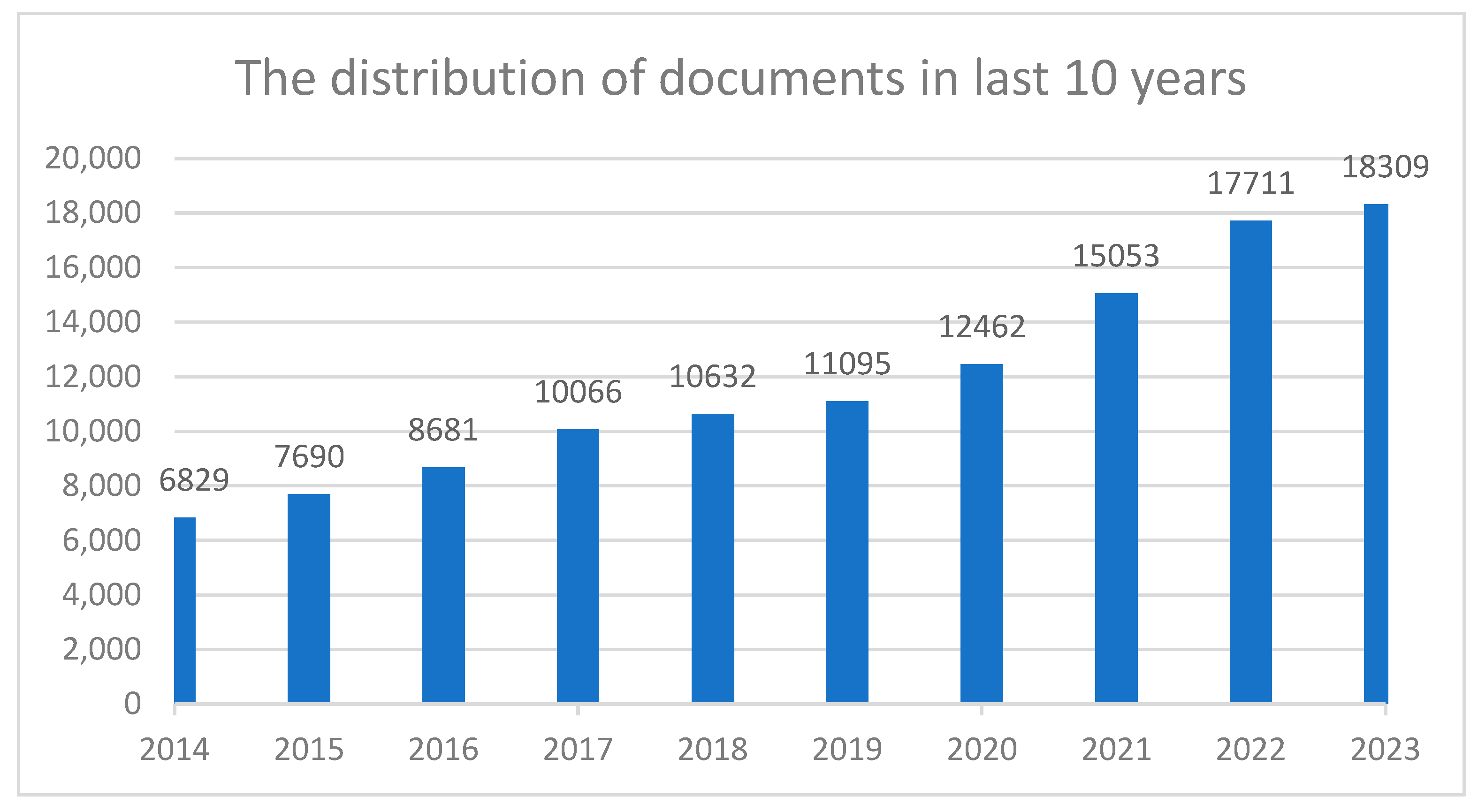
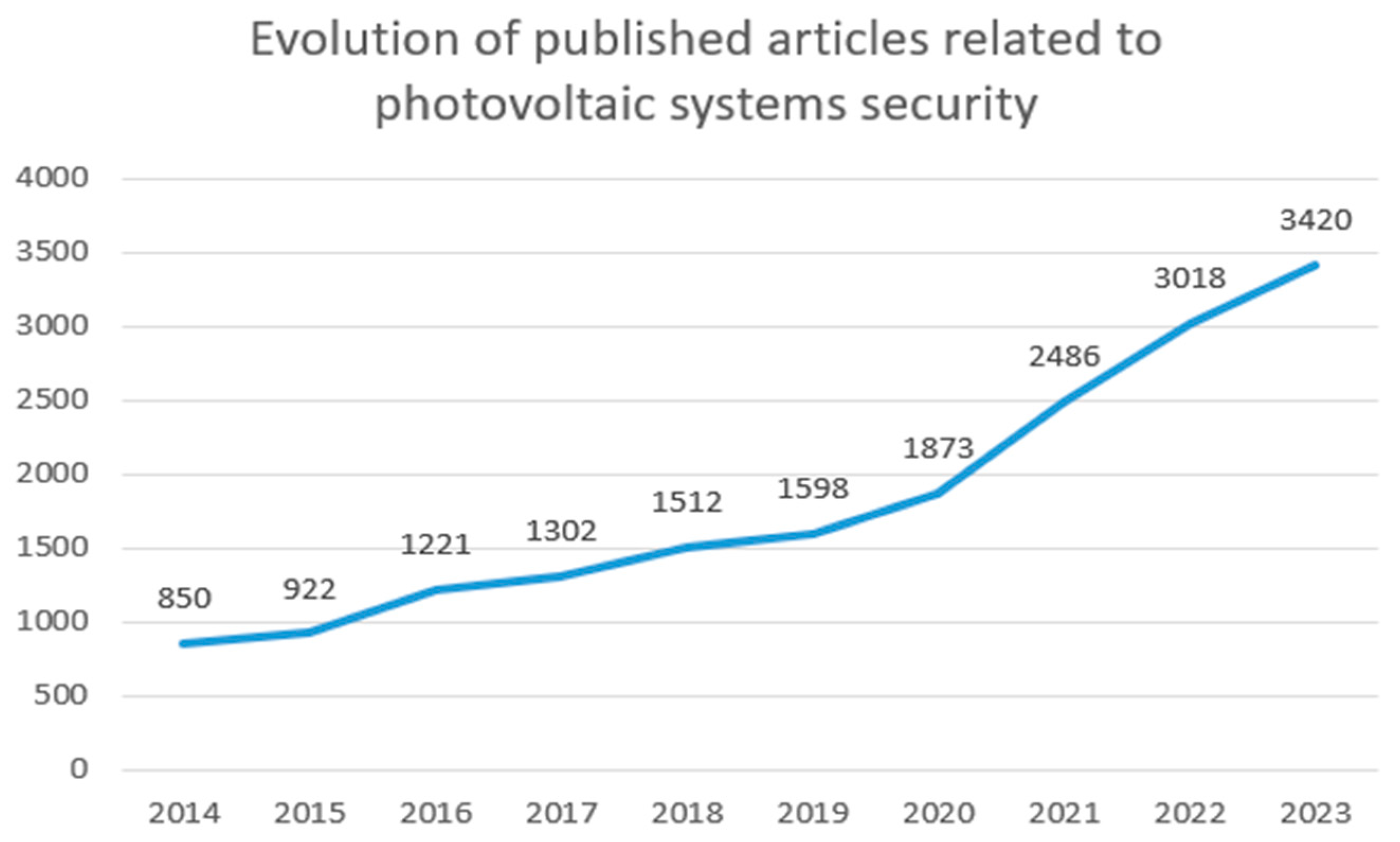

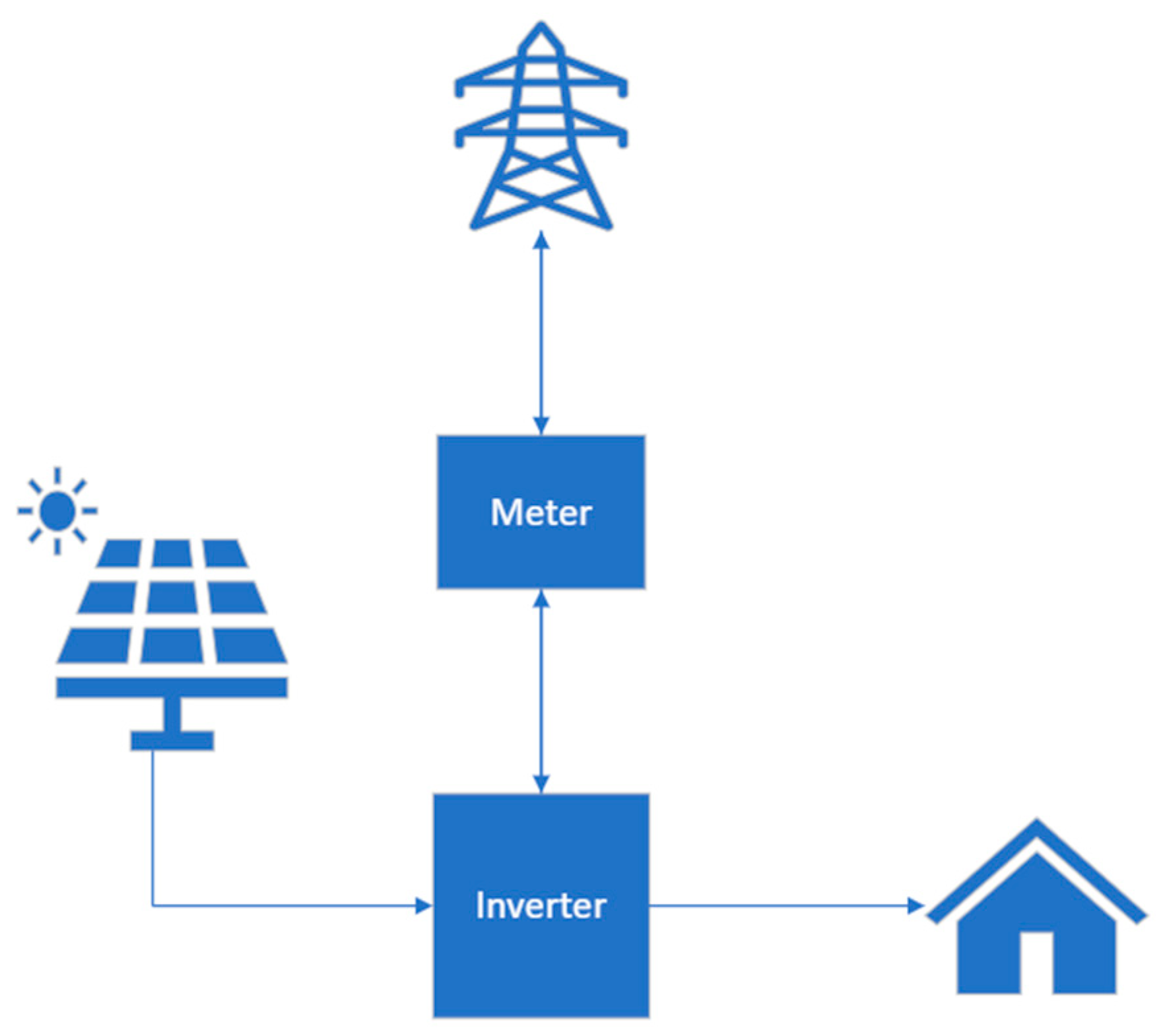

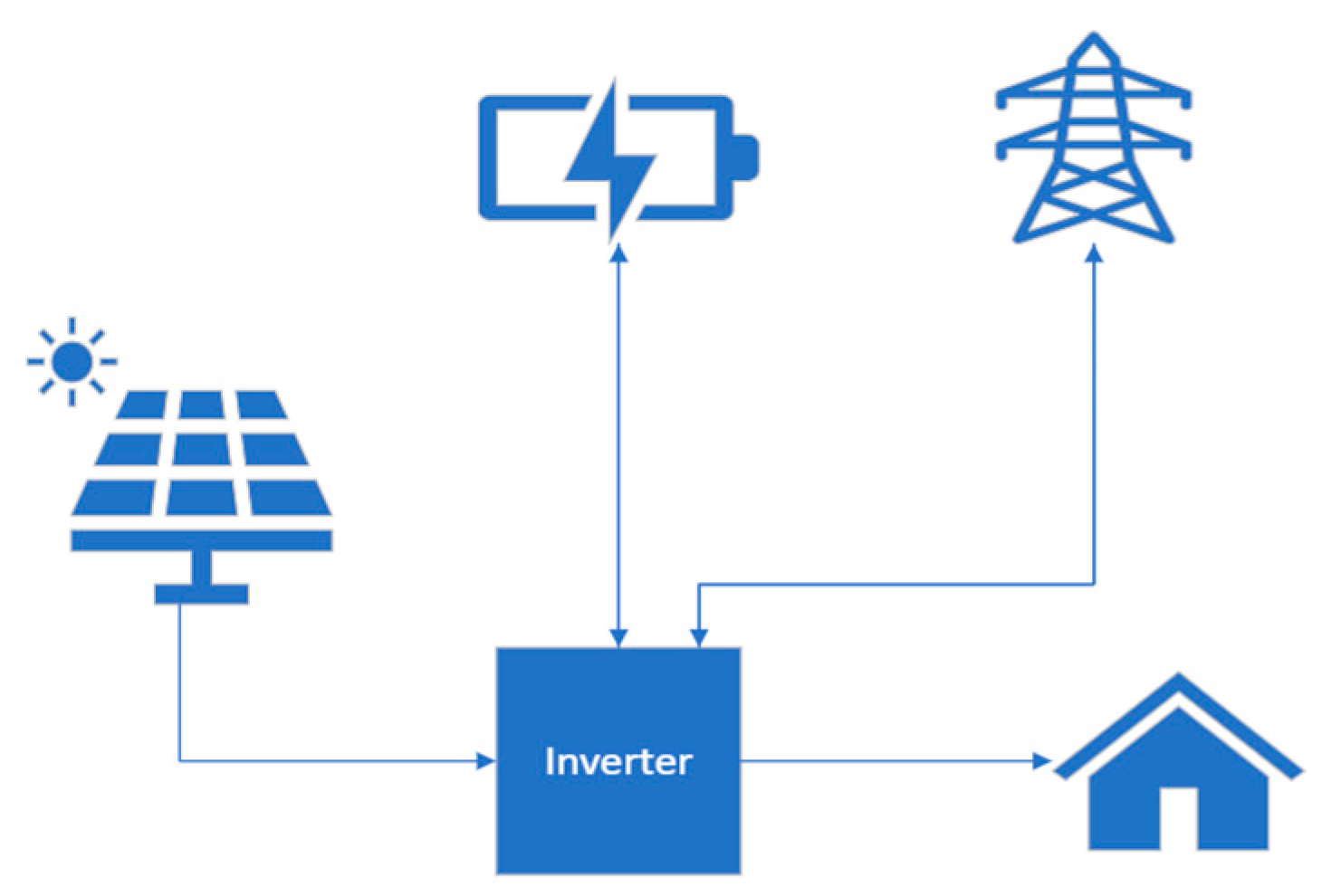
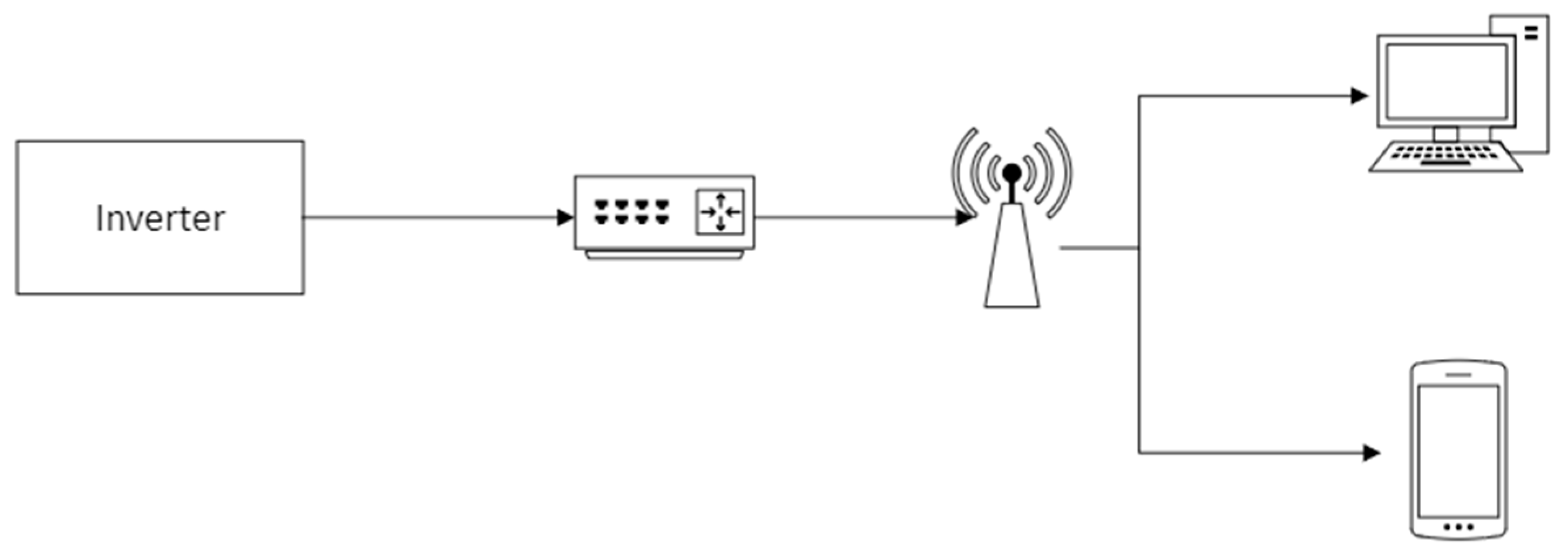
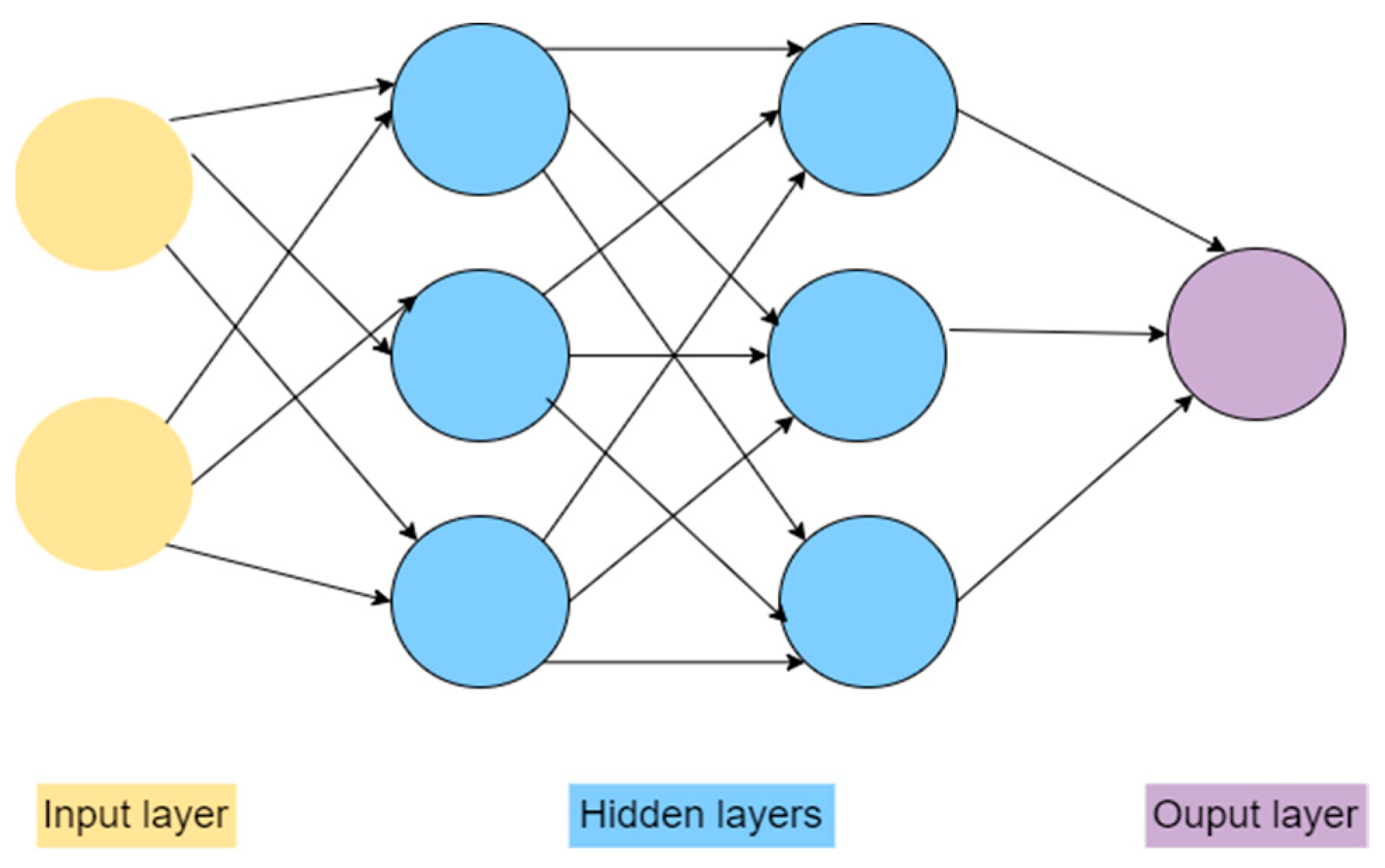
| Ref. | Communication | Description | Comments |
|---|---|---|---|
| [38] | Wi-Fi | The proposed solution is based on open-access software and cloud services, and the data acquisition function collects data in real-time. The control of system consists in On–Off actions. | The system’s remote control is limited to On/Off actions. |
| [39] | Satellite | A remote performance check including an automated failure-detection routine for PV systems has been developed within the PVSAT-2 project. The solution detects and control remotely the failure of devices such as the inverter, but also failures regarding degradation, module defects, grid outages, power limitations, hot inverter, high temperature, and maximum power point tracking. | The proposed solution was tested, but needs significant improvements to be implemented in real world. |
| [11] | Wi-Fi | The LabVIEW software is used to monitor and control. The current, voltage, and temperature values can be controlled. | It is a good and easy solution for systems remote monitoring and control. |
| [40] | Wi-Fi | A sliding mode control for the DC/DC converter is developed, which ensures the achievement of the maximum power point (MPP) under all environmental conditions. Additionally, a proportional-integral (PI) controller is implemented for the DC/AC converter, which guarantees the power quality. When changes have been implemented, the PV system’s signals are measured and remotely managed in order to guarantee the system’s continued operation. | The wireless communication allows the operation of the system in real-time, facilitating the detection of faults rapidly and system’s robustness. |
| Reference | MPPT Method | Description |
|---|---|---|
| [44] | Adaptive Neuro-Fuzzy Inference System (ANFIS) | The ANFIS MPPT technique was leveraged in this investigation. The findings demonstrated that the maximum power point (MPP) could be successfully tracked in partial shading conditions. |
| [45] | Artificial Neural Network (ANN) | A novel method for tracking MPPT was proposed. It was concluded that the proposed method could easily track the MPPT. |
| [46] | Hill Climbing Adaptive Neuro Fuzzy Inference System (HC-ANFIS) | The solution proposed shows that the irradiance and temperature values could be collected in real-time and the maximum voltage predicted |
| [47] | Perturb and Observe (P&O) | The proposed algorithm is based on the utilization of voltage sensors. The results of the simulation and experimental studies demonstrated that the proposed method was effective in enhancing the dynamic performance of the PV system. |
| [48] | Fuzzy particle swarm optimization (FPSO) | A hybrid FPSO was designed with the objective of achieving frequency stabilization under a range of loading conditions. It was determined that the frequency stability was enhanced when the fuzzy logic controller (FLC) method was employed in conjunction with the hybrid FPSO. |
| [49] | Improved Perturb and Observe (IP&O) | An enhanced P&O MPPT algorithm was modelled using MATLAB/SIM-ULINK software. The efficiency obtained in the tests was 99.7%. |
| [50] | Cuckoo Search (CS) | The research compared the particle swarm optimization (PSO), incremental conductance (INC), and CS methods. Under shading conditions, CS has better results than PSO. |
| [51] | Constant voltage (CV) | The algorithm designed automatically modifies the reference voltage, taking into consideration the changing meteorological conditions. |
| Ref. | AI Model | Solar Energy Applications | Discussions and Results |
|---|---|---|---|
| [64] | ANN | PV panel power prediction | The optimal configuration was identified, and the results demonstrated the efficacy of the proposed methodology for short-range power applications. |
| [65] | SVR, BPNN | PV panel energy prediction | In comparison to the traditional ANN model, the SVR and BPNN models demonstrate enhanced prediction accuracy and reduced computational complexity. |
| [66] | ISCE (improved shuffled complex evolution) | Parameter extraction of solar cell models | It is perceived as an accurate and effective method for addressing the factor extraction challenge inherent to solar cell models. |
| [67] | ANFIS | Hourly worldwide, radiation prediction | The ANFIS model demonstrates superior performance in replicating the system output compared to traditional arithmetic models. |
| [68] | ML, SVR | Global solar radiation prediction | The experimental results demonstrate a satisfactory estimation for Egypt and provide evidence of the effectiveness of support vector regression (SVR) models. |
| [69] | GA | Forecasting of solar power | It was observed that there were significant fluctuations in the results obtained in terms of authentic power output, with considerable variation occurring within a single hour. |
| [70] | GA-BPNN | Prediction of mean temperature | The most optimal outcomes were observed when BPNN and GA-BPNN were integrated. This approach may facilitate the development of expedient and pragmatic models for forecasting outdoor heat environments. |
| [71] | GA | Maximum power point tracking (MPPT) solar tracking | The device is employed for the purposes of tracking and control. A microcontroller was designed to facilitate the implementation of the GA tracking technique. It was observed that the system’s implementation was effective. |
| [72] | BPNN | Diffuse solar radiation prediction | The BPNN technique employs a set of characteristics that facilitate the generation of precise evaluation indices. These include data pertaining to the month of the year, mean temperature, daily duration, wind speed, humidity (relative), rainfall, and daily worldwide. |
| [73] | ANN and TRNSYS | Prediction of performance of industrial control systems (ICS) | It has the potential to supplant the necessity for such tests entirely. The system allows for the simulation of individual components and the generation of reports based on the configured parameters. |
| Ref. | AI Model | Advantages | Disadvantages |
|---|---|---|---|
| [64] | ANN | The model is advantageous due to its simple architecture and these algorithms play an important role for remote management of PV systems. | The AI model requires long training time, which is the limiting factor. |
| [65] | SVR, BPNN | Accurate forecasting with less computational modeling compering with other models. | Average forecasting errors. |
| [66] | ISCE | It gave a sound solution to the parametric extraction issue and the ISCE algorithm obtained the best results for parameters extraction from PV cells and panels. | N/A |
| [67] | ANFIS | It gives accurate and feasible predictions. | The algorithm’s performance is dependent in the quality of input data. |
| [68] | ML, SVR | Good estimation and accuracy. | Errors in the training and testing datasets. |
| [69] | GA | Ability to source the spot standards for power prediction. | Complexity of the system and computational resources required for the algorithm to provide accurate forecasting. |
| [70] | GA-BPNN | This approach can lead to the prediction of outdoor mean temperature using reduced computational resources. | Preparation of datasets used for training and testing could be difficult. |
| [71] | GA | The primary advantage is that a non-conventional approach was successfully simulated to provide solar tracking under the same atmospheric changes. | The extraction of the maximum power of the PV panel when the PV panels are partly shaded. |
| [72] | BPNN | The algorithm has accuracy and it is cost-effective. | The estimation of error in the input variables. |
| [73] | ANN and TRNSYS | Few rare situations can be created for testing and evaluating the prediction of ICS performance. | From a financial point of view, the software is expensive. |
| Ref. | Type of PV System | Remote Control | AI Techniques | Cybersecurity Measures |
|---|---|---|---|---|
| [21] | stand-alone | x | ||
| [22] | on-grid | x | ||
| [24] | stand-alone | x | ||
| [26] | stand-alone, on-grid, hybrid | |||
| [27] | Hybrid | low | ||
| [29] | stand-alone, on-grid, hybrid | x | ||
| [30] | on-grid, hybrid | x | ||
| [32] | stand-alone | x | ||
| [33] | stand-alone | x | low | |
| [35] | stand-alone, on-grid, hybrid | x | low |
Disclaimer/Publisher’s Note: The statements, opinions and data contained in all publications are solely those of the individual author(s) and contributor(s) and not of MDPI and/or the editor(s). MDPI and/or the editor(s) disclaim responsibility for any injury to people or property resulting from any ideas, methods, instructions or products referred to in the content. |
© 2024 by the authors. Licensee MDPI, Basel, Switzerland. This article is an open access article distributed under the terms and conditions of the Creative Commons Attribution (CC BY) license (https://creativecommons.org/licenses/by/4.0/).
Share and Cite
Călin, A.-M.; Cotfas, D.T.; Cotfas, P.A. A Review of Smart Photovoltaic Systems Which Are Using Remote-Control, AI, and Cybersecurity Approaches. Appl. Sci. 2024, 14, 7838. https://doi.org/10.3390/app14177838
Călin A-M, Cotfas DT, Cotfas PA. A Review of Smart Photovoltaic Systems Which Are Using Remote-Control, AI, and Cybersecurity Approaches. Applied Sciences. 2024; 14(17):7838. https://doi.org/10.3390/app14177838
Chicago/Turabian StyleCălin (Comșiț), Andreea-Mihaela, Daniel Tudor Cotfas, and Petru Adrian Cotfas. 2024. "A Review of Smart Photovoltaic Systems Which Are Using Remote-Control, AI, and Cybersecurity Approaches" Applied Sciences 14, no. 17: 7838. https://doi.org/10.3390/app14177838
APA StyleCălin, A.-M., Cotfas, D. T., & Cotfas, P. A. (2024). A Review of Smart Photovoltaic Systems Which Are Using Remote-Control, AI, and Cybersecurity Approaches. Applied Sciences, 14(17), 7838. https://doi.org/10.3390/app14177838









